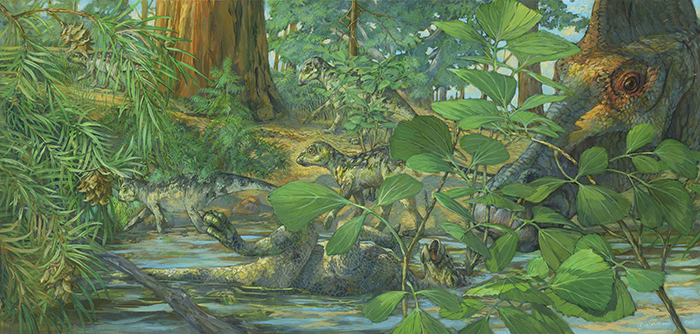
An international team led by Dr. Alida Bailleul from the Institute of Vertebrate Paleontology and Paleoanthropology (IVPP) of the Chinese Academy of Sciences and Dr. Mary Schweitzer from North Carolina State University in the U.S. have presented evidence of fossilized cell nuclei and chromosomes within preserved cartilage inbaby duckbilled dinosaurs. Their findings were published in National Science Review on Feb. 28.
This dinosaur belongs to the genus Hypacrosaurus and comes from a nesting ground discovered in 1988 by paleontologist Jack Horner in Late Cretaceous sediments of northwestern Montana.

Reconstruction of the nesting ground of Hypacrosaurus stebingeri from the Two Medicine formation in Montana. A deceased Hypacrosaurus nestling lies with the back of its skull embedded in shallow waters. A mourning adult is portrayed on the right. (Image by Michael Rothman)
Bailleul conducted microscopic analyses of skull fragments from these nestling dinosaurs. In one fragment, she noticed some exquisitely preserved cells within preserved calcified cartilage on the edges of a bone. Two cartilage cells were still linked together by an intercellular bridge, morphologically consistent with the end of cell division.
Internally, dark material resembling a cell nucleus was also visible. One cartilage cell preserved dark elongated structures morphologically consistent with chromosomes. "I couldn’t believe it, my heart almost stopped beating," said Bailleul.
Bailleul and Schweitzer, together with lab director ZHENG Wenxia, sought to determine whether original molecules were also preserved in the dinosaur cartilage. The team performed immunological and histochemical analyses on the skull of another nestling Hypacrosaurus from the same nesting ground.
They found that the organic matrix surrounding the fossilized cartilage cells reacted to antibodies of type II collagen, the dominant protein in all vertebrate cartilage. "This immunological test supports the presence of remnants of original cartilaginous proteins in this dinosaur,” said Schweitzer.
The researchers also isolated individual Hypacrosaurus cartilage cells and applied two DNA stains, DAPI and PI. These bind specifically to DNA fragments in extant material, and some of the isolated dinosaur cells showed internal, positive binding in the same pattern seen in modern cells, suggesting some original dinosaur DNA may be preserved.
"These new, exciting results add to growing evidence that cells and some of their biomolecules can persist in deep-time. They suggest DNA can be preserved for tens of millions of years, and we hope this study will encourage scientists working on ancient DNA to push current limits and use new methodology in order to reveal all the unknown molecular secrets that ancient tissues have," said Bailleul.
The possibility that DNA can survive for tens of millions of years is not currently recognized by the scientific community. Rather, based upon kinetic experiments and modelling, it is generally accepted that DNA persists less than 1 million years.
These new data suggest that DNA, in some form, may persist in Mesozoic tissues, and lay the foundation for future efforts to recover and sequence DNA from other very ancient fossils.

Cartilage cells from skull of Hypacrosaurus nestlings. (left) Two cells at the end of cell division, showing material consistent with condensed nuclei. (center) Higher magnification of another cell shows chromosomes. (right) An isolated dinosaur cartilage cell reacts with the DNA stain propidium iodide (red dot, inside the cell). (Image by Alida Bailleul and ZHENG Wenxia)

86-10-68597521 (day)
86-10-68597289 (night)

86-10-68511095 (day)
86-10-68512458 (night)

cas_en@cas.cn

52 Sanlihe Rd., Xicheng District,
Beijing, China (100864)

